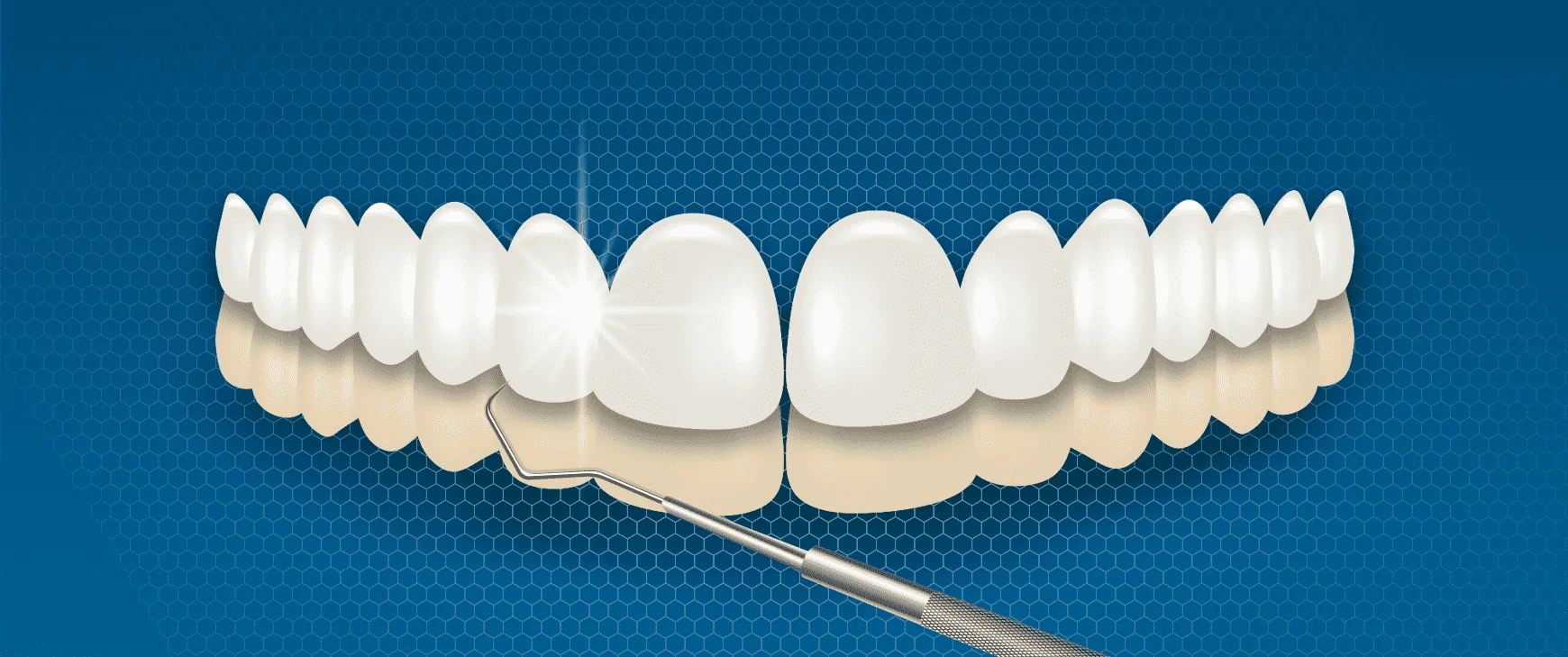Laminate Veneers
Salih ÖNDER2024-11-06T22:24:02+03:00The key to a beautiful smile is through beautiful and healthy teeth. However, in some people, smile aesthetics may deteriorate due to reasons such as discoloration, bruises, and crowding in the front teeth, and people may not be satisfied with their smiles. In cases where smile aesthetics is insufficient, people may experience many psychological and social problems.
In the past, veneers, which were made to reshape the teeth and increase the smile aesthetics, caused some problems as they required a large amount of abrasion and reduction in the teeth. But nowadays, with the development of porcelain laminates, it has become much easier to achieve a beautiful smile.
Dental Group Hospitadent is at your service in all its branches and with its expert physician staff to reflect the opportunities provided by technology, including lamina veneers, to your smile.
What is laminate veneer? What are the advantages?
Lamina veneers, also known as leaf porcelain, are aesthetic veneers applied especially to front teeth. For these veneers, no or very little abrasion is made on the teeth. For this reason, healthy tooth tissues are preserved. Lamina veneers, which are designed in a very thin structure, cover only the front surfaces of the teeth and in some cases the incisors.
Who are laminated veneers for?
Lamina veneers can be applied to anyone who has completed the development of their teeth and jaws and is not satisfied with the appearance of their teeth and smile. We can list the situations where laminate coatings are needed as follows;
- In cases where there are fractures and abrasions in the anterior teeth
- In people who have tooth discoloration to the extent that whitening treatments are not sufficient
- In cases of mild crowding of patients who do not prefer orthodontic treatment
- In patients who cannot achieve adequate smile aesthetics after orthodontic treatment
- In cases where there are spaces called diastema between the front teeth
- Superficial caries on anterior teeth
- In cases where tooth length is disproportionate or short
- In cases where tooth enamel is genetically rough or there are structural defects
- In the presence of anatomical disorders in tooth shapes
- In the presence of discolored and worn old fillings
- As part of smile design
What are the Advantages of Laminate Coatings?
One of the most important benefits of laminate veneers is that they have high aesthetic properties. Thanks to the properties of the ceramics used in their production, the desired color and image can be created on them, allowing to obtain a natural appearance as well as being beautiful. For this reason, it is one of the most used coating methods when designing a smile.
Lamina coatings, which do not easily discolor due to the smoothness of their surface structure, can be used for many years without discoloration problems caused by substances such as tea and coffee, in patients with good oral hygiene.
In addition, it is a great advantage for lamina veneers not to lose unnecessary material in healthy teeth.
Abrasion and reduction of healthy teeth for aesthetic purposes has always been a matter of debate. However, this problem is eliminated with laminate coatings. In this way, it is possible for the patients to be much more comfortable and comfortable both during and after the treatment.
Lamina veneers can be applied to a single tooth or to more than one tooth at the same time, and they are adhered one by one. In this way, cleaning between the teeth is much easier than the veneers made in blocks. Moreover, they have a much more natural and beautiful appearance while smiling compared to the veneers made in blocks.
Are laminate coatings durable?
Lamina veneers are manufactured from high-strength porcelain. Therefore, they are extremely resistant to abrasion. However, due to their thin structure, they are more sensitive than metal-supported or empress porcelains that surround the entire tooth. For this reason, they are not recommended to be applied to the back teeth where the chewing force is felt high.
Lamina veneers applied correctly to the right area can be used healthily for many years if necessary care and oral care are provided.
What should be considered in laminate coatings?
Lamina veneers are prostheses that require precision both in preparation, measurement and application. For this reason, it is important that the treatment is performed by a physician with high hand sensitivity and experienced in lamina veneers.
Laminate coatings are extremely resistant to abrasion forces, but due to their thin structure, vertical forces can cause fractures. For this reason, it is recommended to use with night plates in patients with teeth clenching and grinding problems.
Lamina veneers are in perfect harmony with the gums. For this reason, any discomfort that may occur in your gums can disrupt the harmony of the coating and shorten its lifespan. Therefore, it is necessary to give extra importance to oral hygiene. In addition to brushing, the use of dental floss and mouthwash should not be neglected.
It is recommended that patients who have habits such as nail eating or chewing hard foreign bodies stop these habits before lamina veneers are applied.
It is necessary to avoid biting foods that will exert excessive force, such as hard-shelled foods with the teeth on which laminate veneers are made, in order to avoid damaging the veneers when trying to open or break any hard object.
Dentist controls made twice a year are also important in prolonging the life of lamina veneers by taking the necessary precautions.
It might interest you –> Antalya Dental Clinic
How long do laminate veneers last and how are they made?
First, the patient undergoes a comprehensive oral examination. General oral hygiene and health are determined.
If deemed necessary, gingival treatments, cleaning and tooth whitening treatments are applied for teeth where lamina is not planned.
If there are cavities on the teeth to be treated, they are cleaned.
If there is a disproportion in the size of the gums or other aesthetic problems, these are corrected with minor surgical procedures before lamina applications.
Photographs are taken to determine the condition before the procedure.
A temporary application is made on the teeth with composite material, and the image that will form at the end of the treatment is presented to the patient. At this stage, the teeth are not damaged. If the patient has other aesthetic expectations in the planned teeth, they are included in the planning at this stage.
The temporary application is removed from the tooth. If necessary, a very small amount of abrasion is made on the teeth with the help of special burs.
Models are obtained by measuring the teeth with special impression materials.
The color of the teeth for which the procedure is not planned is determined and the colors of the lamina veneers to be made are decided.
Sometimes, digital dentistry applications called “cerec” are used. In this case, a special powder spray containing titanium is applied on the teeth, and digital tooth models are created in the computer environment by taking measurements with the help of a micro camera. In these cases, the design and production of lamina veneers is carried out in the device with computer aid. This is one of the most precise laminate veneer creation methods known. This method allows the treatment to be completed in a single session.
In another method, lamina veneers are obtained by processing porcelain on the models created by the measurements taken. Since there will be an additional technician stage in this method, it is possible that the treatment will take several sessions.
The created lamina veneers are rehearsed in the patient’s mouth; If there is no problem, they are adhered to the tooth surfaces with special processes called adhesive methods.
Lamina veneers can be made in 1 full day with the development of Digital Dentistry. However, the dentist can give the exact treatment time after the examination.
For those who are interested in –> Hollywood Smile Turkey
What are the obstacles to laminate coatings?
In cases where there is excessive crowding in the anterior teeth, lamina veneers may be insufficient and orthodontic treatment may be needed first. In such cases, other coatings with more abrasion may be preferred. In patients with excessive clenching problems, it is recommended to solve the clenching or grinding problems before starting the lamina veneer procedures.
Dental Group Hospitadent is at your service both in all your oral and dental health treatments and in your post-treatment controls, with its expert physician staff, in all its branches.
For your information –> Dental Implants Turkey
Treatment Summary
Number of Transactions
2-3
Return to Work Process
Now
Processing Time
10 Days
Full Recovery Process
Now
Anesthesia Method
Local anesthesia
Persistence of Results
5 Years
Sensitivity Process
Non
Eating - Drinking Process
2 Hours Later
Note: *The information and recommendations on this page are for informational purposes only. Please consult your doctor for diagnosis and treatment. WhatsApp line.
Bütün İşimiz Diş


